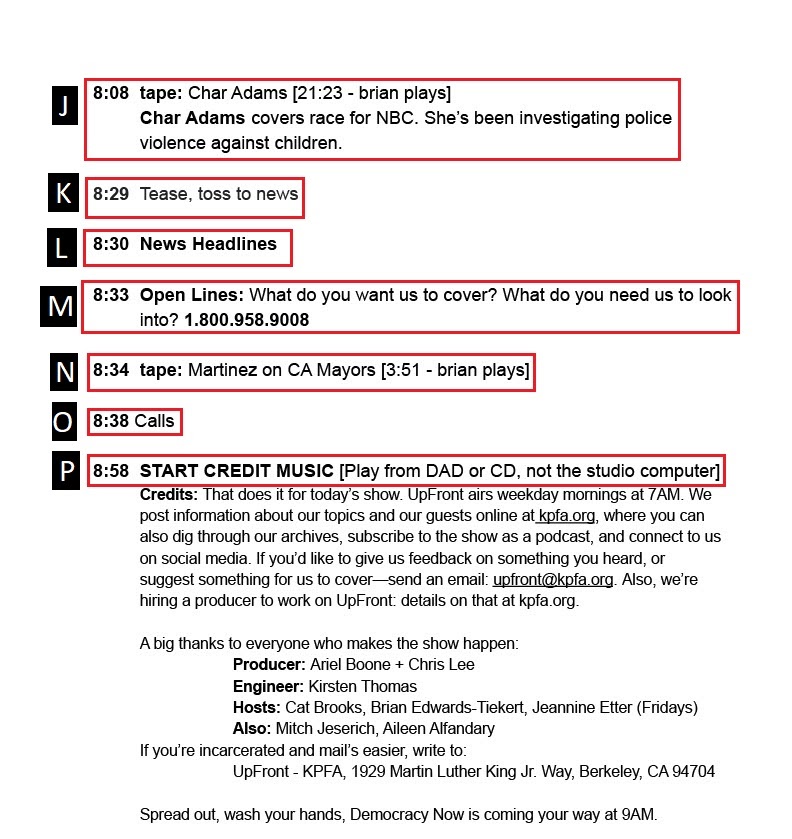Setting Up for a Live Show
- Make sure the board is normalized to how you’d like to use it by pressing the NORM buttons (NORM TALK, NORM MUSIC, etc.).There are four normalization buttons which will configure the board differently for different show formats. Normalizing the board to the different configurations (Norm Talk, Norm Music, etc.), you will notice that the assigned audio sources to each fader will change. If the board looks different, such as faders being in the wrong place or certain fader sources aren’t available, try switching between normalizations.


- Check the day’s Operator Log to familiarize yourself with your shift’s lineup.
- Check [email protected] Gmail account as well as Google Drive for a runsheet, print runsheet.
Once you have the show’s runsheet, you can begin preparing for the show. - Have the show’s theme music ready as well as backup miscellaneous music in case of an emergency.
Show theme music CDs are available on the CD rack labeled “PROGRAM THEMES.” If you prefer playing them through the computer, you can locate show themes by going to:TEMPS > #FOR BROADCAST ON AIR > THEME MUSIC. - Have email open (onairstudio account), to stay on top of any important communication.
- If communicating with the host/producer through Google Hangouts, have that window available.
- Look over the runsheet to figure out logistics, for example:
- Skype calls
- Phone calls
- IPDTL calls
- Audio files to play
- End time to allow automated carts to play (:58 or :59)
- Familiarize yourself with what faders you will be using.
- ≈ 10 minutes prior to the start of the show, check the host/s mic and sound levels, check talk-back function. If the show is being done remotely, connect to the host/s and check the same.


A runsheet is a detailed plan for a specific episode of a radio program. It enables the host, producer, board operator, and any others involved in the program to coordinate their actions around a shared schedule. This is especially critical when episodes require a producer or a board operator to play recorded audio or turn mics on and off. Let’s break down each segment on this runsheet.
A. With the show starting at 7:00, this informs you to and how to connect to your host to check their audio levels and overall connection. As you can see this show will be done remotely, meaning that the host will connect using a web-based podcasting service. Note that shows will primarily be done live, meaning that your host or hosts will be live in the studio and you will need to check their microphone connection and audio levels.
B. Billboard refers to the show’s opening intro. At 7:00 you should play the intro music and turn on the host’s microphone.
C. During this particular show, the host will turn it over to the news anchor for a news segment at 7:01, and return at 7:08.
D. This next segment is an interview with Dean Baker at 7:08. The runsheet provides you with their preferred contact method (Skype) as well as a back-up number in case Skype fails. Since the segment is at 7:08, allow yourself time before that to establish contact. Let the host know that you have their guest on standby.
E. At 7:30 the host will once again turn it over to news for another news segment and return at 7:33.
F. This next segment will consist of an interview with two guests :Veena Dubal and Dara Kerr. Contact information is provided, again, allow yourself time to establish contact. Let the host know that you have their guests on standby.
G. At 7:38 the host will open the phones to the audience. Be prepared to take phone calls and put them on air when the host instructs you to do so.
H. The host will wrap up the callers segment and at 8:00, will tease the next segment as well as read the station ID.
I. Back to news at 8:01.
J. Back from news to another interview with Char Adams at 8:08. Allow yourself time before this to line up the guest. Let the host know that their guest is on standby.
K. Host will tease the next segment and toss it to the news.
L. News segment for a few minutes, returning at 8:33
M. Host poses a question and opens up the phones for the audience to call.
N. This next segment consists of a pre-recorded audio file. Runsheet indicates that the host will play it. Note that sometimes you will be responsible for playing the audio files and further instructions will be provided.
O. Host will now take callers.
P. The show is coming to an end and as noted, the board op. should start playing outro music at 8:58 as the host closes the show by reading credits.
 TIPS
TIPS
-
- Communicate with the host or the producer if you have any questions regarding the runsheet.
- If filling in and not exactly sure what the intro and outro of the show should sound like, visit KPFA’s online archives and familiarize yourself with the intro and outro of the show in question.
- If the show runs long and you cannot get to the scheduled automated carts, be prepared to read the station ID live and transition to the next show. See Legal ID Requirements page.
- Be mindful of emails coming in notifying you that pre-recorded shows have been submitted. Although most of the time the station’s Traffic Director will load these shows for automation, it is a good idea to download the shows and add them to the day’s folder (TEMPS > #FOR BROADCAST ON AIR > the day’s folder). If the Traffic Director is not available you can play the show off the computer, or, if you know how, load the shows onto DAD yourself for automation. Always reply to emails letting them know that you have received their audio file. See How to Download, Archive and Load Pre-Recorded Shows to DAD info page.
- Keep an ear open for any obscene/foul language to dump. See Indecent Language Over Air/Dump Button info page.
- If you need login information for email, Skype, etc. See Important Login Information page.

